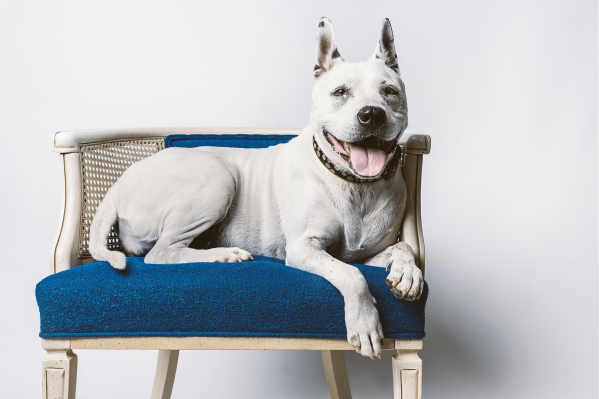It’s pretty easy to pick up on your dog’s habits. You probably know which bark or cry means your dog wants to go on a walk, and which sound means they’re hungry.
But when it comes to medical issues, it’s up to you to do some extra investigating and pay attention to silent behaviors.
If your dog’s not in pain, it's likely they won’t alert you that anything is wrong, but things like walking funny, not using a certain paw, limping, having trouble rising from the floor, or walking up and down stairs can all be telltale signs that it’s time to see a vet about Canine Hip Dysplasia (CHD).
What is hip dysplasia in dogs?
Hip dysplasia is the abnormal development of the coxofemoral joint, aka, the hip. It is a "ball-and-socket" joint, where the "ball" is the head of the femur and the "socket" is the acetabulum. With hip dysplasia, these are growing at different rates and can cause joint laxity and looseness.
Hip dysplasia is one of those conditions you have to look out for, especially in larger dog breeds. If left untreated, hip dysplasia can turn into degenerative joint disease (osteoarthritis).
Here’s how to spot the signs of hip dysplasia in your dog, which dogs are prone to getting it, and what you can do if you discover your dog has this condition.
What causes hip dysplasia in dogs?
While hip dysplasia’s cause is not entirely known, veterinarians assume that it's mainly genetic and an inherited condition.
This means that hip dysplasia can occur in young dogs, but may not be diagnosed—or even noticed—until the dog is much older. If it is not diagnosed until a dog is older, it may be accompanied by arthritis.
Large and giant breeds such as labrador retrievers, golden retrievers, German shepherds, Newfoundlands, and rottweilers are most prone to having hip dysplasia.
Signs your dog has hip dysplasia
There are a few classic signs that will alert a vet that your dog has hip dysplasia.
”Bunny-hopping” - This is when a dog lifts both hind legs at once and appears as if they're hopping like a rabbit. This occurs because the dog’s hips are luxating outside the hip socket.
Lameness, an ability to use one or more limbs
Limping on one or both hind legs
Difficulty rising up
Wobbly movements
If your dog is limping or showing signs of lameness (even if it is intermittent), you should speak with your veterinarian. They will be able to examine your dog and may perform radiographs (x-rays) to rule out the presence of hip dysplasia.
Treatments for hip dysplasia in dogs
There are a few different options to treat hip dysplasia in dogs:
Surgery for hip dysplasia
An early diagnosis for hip dysplasia is key to effective treatments. It can be surgically corrected with various procedures.
The two most common surgical techniques for hip dysplasia are a total hip replacement and femoral head ostectomy (FHO). Other surgical procedures used to treat hip dysplasia include triple pelvic osteotomy (TPO) and juvenile pubic symphysiodesis.
The type of surgery that’s best for your dog will be based on your dog’s age, lifestyle, and the severity of the disease.
Medications & supplements for hip dysplasia
If you do not wish to schedule your dog for surgery or if your veterinarian doesn’t recommend it, there are medications that can help manage hip dysplasia. Your veterinarian may prescribe NSAIDs and exercise restrictions to minimize further damage on the hip joints. There are also hip/joint supplements you can add to your dog's regular diet.
Made with ingredients like Glucosamine, Chondroitin, and egg shell membrane, these promote healthy joints and hips and taste delicious to dogs.
Some vets recommend integrative approaches to hip dysplasia, whether this is combined with surgical correction or not. These include physical rehabilitation therapy, acupuncture, and laser therapy treatment. Physical rehabilitation in particular has proven to be essential in a dog’s recovery after a surgical correction of hip dysplasia, as it helps speed recovery and increase strength in your dog’s muscles.
Home remedies for hip dysplasia
If you want to make your dog more comfortable at home after receiving a hip dysplasia diagnosis, ensure that the surfaces in your home are easier for your dog to walk on. Adding rugs, mats, or anything that makes a surface non-slippery will help.
You should also help your dog limit the use of stairs in the home, and if possible, lift your dog in and out of the car or couch as needed.
How to prevent hip dysplasia in dogs
Unfortunately, since hip dysplasia is genetic, it’s not entirely preventable.
Dogs with hip dysplasia who breed will most certainly pass it on to their puppies. There are also environmental factors which have been correlated with hip dysplasia, including early neutering and obesity.
Communicating with your veterinarian about an appropriate time to get neutered or spayed for your dog’s breed and age, and helping your dog maintain a healthy weight may help prevent hip dysplasia in dogs who were not born with it.
If you're worried that your dog might be at risk for hip dysplasia or want a recommendation for supplements and medication, our Pawp Professionals are here to help 24/7.

Reviewed and fact-checked by
Mika, RVT at Pawp
